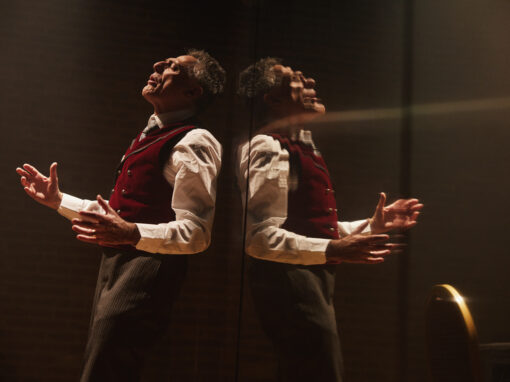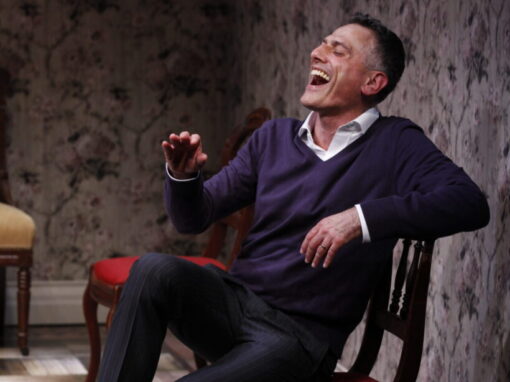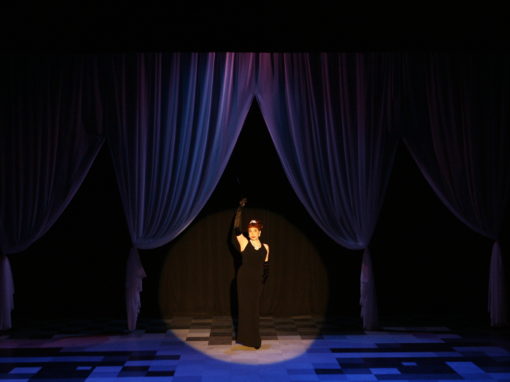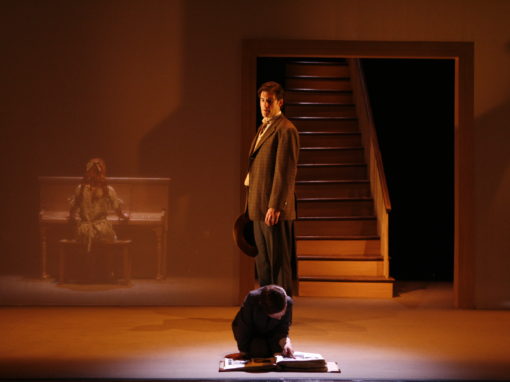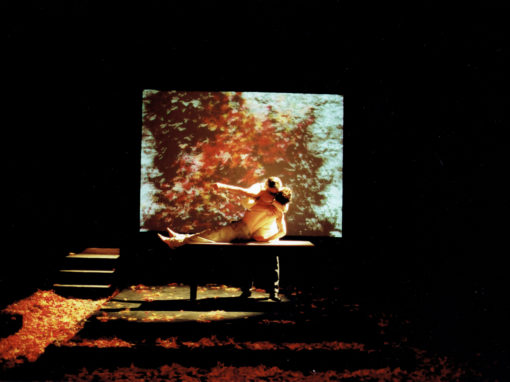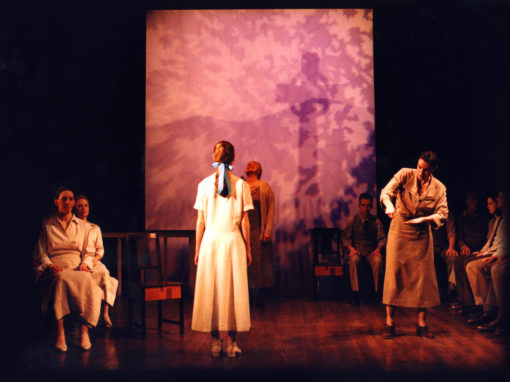What I Can’t Have and Never Thought I’d Want // by Jack Cummings III
Director Jack Cummings III loathes and longs for the #1 wish on his Christmas list.
Christmas Day is almost here. What I hope to find under our tree on Christmas morning will not be there. It would be impossible actually. What I want for Christmas is an audience. A live one to be exact. What truly pisses me off is not the fact that I won’t get one—but that I want one at all.
You see, I have a rather “complicated” relationship with audiences—one that resembles a strange cross between Albee’s George & Martha and Brontë’s Cathy & Heathcliff. Confused? Welcome to my world.
You might be rightfully wondering what exactly is my problem when it comes to an audience? At the risk of shoving a pad and pen in your hands and flopping down on your couch for the next several months, let me put it to you this way: I CAN’T STAND THE FACT THAT I CAN’T CONTROL THEM! There I said it. Don’t get me wrong—when an audience loves your show (and preferably stands to let you know just how much they love it), nothing could be better. You go to sleep that night thinking nothing is wrong in the world. But when they don’t love your show, your inner Lizzie Borden starts heading to the hardware store for the best hatchet money can buy. Any theatre artist who says this isn’t true is LYING.
When you put together a show, you have the gift of gathering in a room for many weeks with fellow artists and collectively creating something you hope will be special. Everyone has the luxury of being able to stop and redo anything they like, as often as they like, until they are satisfied to move on to the next moment. But then you get into the theatre, start performances, and all of a sudden, this mob of people you have never seen before in your life enter, sit, and WATCH. To be clear, everyone in that theatre has rehearsed and knows what to do—except this huge group of strangers, who unfairly outnumber everyone else! And if they get it wrong—not laughing when they’re supposed to—not getting a lump in their throat when they’re supposed to—you can’t do a damn thing about it. You can’t stop the performance and say to Row F, “Excuse me, that line and accompanying delivery by our lead actor was actually hilarious, so we’re gonna take it back and this time, you’re gonna need to laugh harder than you have ever laughed in your life—CAPEESH!?” Apparently, polite society dictates such an action would be rude. Harumph.
Over the years, my relationship with audiences has been so fraught that I once conceived and directed a musical about them. Guess what it was called? The Audience. Yep. Why bother with nuance when you can cut straight to the chase? Looking back, it was probably my naive attempt to make peace with an aspect of my chosen career that seems to delight in torturing me.
The year was 2005. Transport Group was four and I was thirty-seven. It started out so innocently. I wanted to tell a story about an audience attending the premature closing of a Broadway musical considered “artful.” Among the audience at this closing performance is the show’s tortured writer (played by Jack Donahue) who rather than watch from the back, bravely decides to sit in the middle of the house so that he can fully experience his show for the last time. To tell this story somewhat believably, we needed a cast large enough that could represent a cross section of an actual Broadway audience. The number of actors needed kept rising until I was mercifully cut off at 46: five rows of nine seats each plus two usher characters.
As my idea kept ballooning, I started to realize my own limitations and reached out to my friend and playwright, Adam Bock, who graciously stepped in to help me. We sat together and came up with ideas for characters—who would actually populate this Broadway audience? Adam wisely suggested that even in naming them, there would be a need to embrace archetypes and then allow for nuanced details to emerge later. They ran the gamut—to name just a few: The Ladies From Westchester, The Older Gay Couple, The Japanese Tourists, The Out-of-Town Family, The Four Old Jews, The Staten Island Secretaries, The Out-of-Town Parents & Their Manhattan Daughter, The First Date Couple, The African-American Yuppies, and The Obsessed Fans. In total, the show would contain 19 storylines covering 46 characters, each set of characters written by a separate playwright. And to make it even more complicated, certain storylines/characters would have a song that reflected their own internal life, each written by a different composer/lyricist. Between playwrights, composers, and lyricists, 29 different writers would end up writing the show.
The final question Adam and I needed to answer was what our Broadway audience was specifically watching—we couldn’t just leave it at an “artful Broadway musical.” Although this unseen fictional show would never be named, the company still needed something to work with in rehearsals. After much discussion, we decided they were watching a show similar to Falsettos: a show dealing with life, death, family, homosexuality, AIDS—an artful show that made it to Broadway but didn’t have a long commercial run—i.e., the perfect fit for our needs.
I recall going to the first rehearsal incredibly excited—a new adventure! Everyone seemed so happy—that is until we did the read-through. The individual writing wasn’t the problem. The problem was how I had put it together. It didn’t make sense, it was waaaaaaay too long, and worst of all, it was tedious. I was flummoxed. And by flummoxed, I mean DEVASTATED. On the subway ride home that night, I stared catatonically into space as if I had just been evicted from my apartment. From that day forward, I never went to another rehearsal without some level of nausea.
It was chaos. Trying to tell 19 different stories somewhat simultaneously was overwhelming to say the least. Each individual “play” had to be broken up into bite-sized segments while still maintaining a through-line and an arc. Each writer had given their characters such wonderful stakes that I wanted to make sure we never veered from honoring those intentions. And in order to properly rehearse it, all 46 actors had to be there the whole time (oh boy). Every rehearsal would reveal yet another difficult challenge I had never anticipated. One example of this was when it became obvious that to be an actor in this show, you needed to accept the fact that you were but a tiny piece of a huge mosaic. For better or worse, I had cast a company of mostly principal actors and so this realization didn’t always go over too well. While some naturally embraced the “mosaic,” others needed time to shift their mental gears. For me, I continued to stare catatonically on the subway home.
The show ended up being divided into five segments: the audience pre-show entering/chit-chatting/settling, the audience watching the first act, their intermission, the audience watching the second act, and the audience post-show talking/gathering/leaving. Oddly, the segments that ended up being the toughest were the pre-show/intermission/post-show. For these, we concluded that in order for it to be “realistic,” all 46 actors would have to be talking the whole time while whichever scripted story needed to be heard would have to rise above the “Buzz,” as we came to call it. AND we had no mics so to manually orchestrate this was a nightmare—everyone had to talk and be fully engaged with their scene partner but also keep an ear out for their respective “cue” in order to seamlessly take over the vocal spotlight, so to speak. This became particularly difficult if you were in the fifth row and your “cue” was coming from the first row. The late Marta Curro, one of “The Four Old Jews,” was hard of hearing and so we came up with a system whereby the much younger actor next to her would listen for her and then squeeze her arm when it was her time to speak. At a certain point, my notepad was littered with phrases like this: “Buzz is too much”—“Need more Buzz”—“Buzz is good”—”Let’s dial back Buzz”—and my personal favorite, “What happened to Buzz?”
In addition to The Saga of Buzz, there was endless rewriting, restructuring, and reconceiving (writers Mark Campbell and David Pittu saw me drowning, kindly pulled me to shore, and started helping, thank God). We realized early on that while interesting, the “Audience” had nothing to collectively push against. They had no scene partner. There was no overall drama. We determined the solution was in the character of the Writer (named Jeremy Lane Shawn—a name that still makes me laugh for some reason). It’s his show—it’s closing early—and so for him, the stakes couldn’t be higher. And here he is surrounded by a horde of people with their own personal dramas. We decided that as the show progressed, the Audience would unknowingly need to drive the Writer to the brink of insanity. Whether it was the proverbial coughing, talking too loudly, reading the program at the worst time—whatever we could come up with to torture him, we put it in. Poor Jeremey Lane Shawn. At one point during the intermission, he strikes up a conversation with one of the ushers—she’s young and this is only her second night on the job. Trying to be nice, he asks her how her first night went. Mistaking his question and not knowing who he is, she launches into an unhinged monologue detailing what she thinks is wrong with the show and tells him it was clear the audience didn’t like it either as many of them left at intermission. Devastated, he takes his seat to watch the second act. Then, a short while later, one of “The Obsessed Fans” is caught recording the performance which grinds the show to a halt while the Head Usher drags her out of the theatre screaming.
As the individual storylines became clearer and the Audience vs. the Writer storyline became clearer, what was NOT becoming clearer was how to tell these stories together. We would make progress only for that progress to come crashing down before our eyes five minutes later. Everyone was starting to get a little cranky. One actor came up to me on a break and stated unironically, “A chicken could play my part.” Another actor made it a daily ritual to figure out a way to convince me that it was only humane to let him out of the show. At one point, I realized a beautiful song in the second act needed to be cut for purely structural reasons. When I called the composer to tell him the unfortunate news, he said, “If you cut my song, I will burn your house down.” Then he hung up on me. My catatonic subway rides had now reached Olympic Gold Medal status. I was the Michael Phelps of Catatonic Subway Riding.
I’m not sure exactly when or how things started getting better—maybe God looked down and felt sorry for us and decided to show us some mercy? Who knows? Theatre sometimes is the weirdest animal known to the universe. I do have some theories though. Every few days something would work and miraculously NOT come crashing down five minutes later—it would actually stay. One day, Mark Campbell and Steve Marzullo came in with an opening number for the entire company called “Why Do I Go To The Theatre?” This was the number the cast would sing while they were simultaneously watching the opening number of Falsettos/Not Falsettos. In it, we would get a glimpse into the hearts and minds of every single character who are each wrestling with why they even go to the theatre in the first place. With 46 people, you can imagine how all over the place their thoughts were but one of my favorites was a character in the fourth row whose only internal thought was her grocery list, “…paper towels, chips, Cheerios, roach traps…” At the song’s conclusion, there would be two audiences clapping: one onstage for an unseen opening number and one in the house for the opening number that actually happened. Another musical moment in the show that gave us all hope involved a little boy in the second row who had never seen a Broadway musical. During the show, we see him slowly fall in love with the humanity he’s witnessing on stage—a young Eamon Foley would end up stopping the show with an aptly named song by Cheryl Stern and Tom Kochan called, “I Like What I See.” And then one day, Jeff Blumenkrantz gave us all a gift with a song he wrote for the legendary Rita Gardner, called “I Think.” In James Hindman’s tender story “The Ladies From Westchester,” Rita’s character is a recent widow who has secretly brought to the theatre the urn containing her dead husband’s ashes. She and “Sal” used to go see a Broadway show once a year and this is her first year at the theatre without him. She takes out his urn, holds it in her lap, and proceeds to tell him all about what she’s seeing. By the end of the song, she realizes she needs to move on and sweetly tells him next year she’ll leave him at home so he “can watch a basketball game.”
These moments started to give our bedraggled and frustrated room some hope. And with each glimpse of hope, we started to silently build faith that there was a chance for this story to work after all—if we could just hang in there. That was the key—to hang in there. Hope, faith, and hanging in there while ever elusive are also thankfully, infectious—and with a room of over 60 people at any given moment, the chance of these spreading was highly possible. And spread they did. Yes, there were setbacks and yes, they felt debilitating. And while there was a myriad of things that still didn’t work, I was absolutely sure of one thing: I was surrounded by incredibly smart people. The pace at which I was learning from them was often overwhelming. Subconsciously, I knew their collective talent would take us across the finish line. And I remember the moment we crossed it.
By this point, we were in the theatre. Previews were to begin in a few short days and thankfully we had been making much needed progress in the second act. We knew we needed to get the Writer to reach a breaking point but realized we had to keep his climbing blood pressure a bit of a secret, so the audience wouldn’t get ahead of us. We determined the way to do this was to take the most fraught moments within the individual stories and begin to pile them on so his breaking point would erupt out of deep tension—even if that tension belonged to other people. At precisely the right moment, Murray, one of “The Four Old Jews,” coughs a single, barely audible cough. And that was it. In a moment of suspended time and space, the Writer stands up and screams over and over and over, “SHUT UP! SHUT UP! SHUT UP!” And this was only the beginning of an enormous rant during which he would go up to several particularly egregious audience members and rip them apart for the theatre-going crimes they had subjected him to since the show began. Think Howard Beale in Network. While we were rehearsing this climatic moment, Michael John LaChiusa arrived with his song, “Two Joins Three”: the Audience’s stunning musical response to the Writer’s rage-filled tirade. The level of fantasy was now at a new level. Different from the opening number wherein they were individuals, now in Michael John’s hands, they were a single body—a united front about to tell this irate author a thing or two. Slowly building as the song goes on, they firmly inform him:
You cannot control the many thoughts I have
You cannot prevent my choice to leave
You cannot coerce my hands to clap a lot
I cannot be forced to laugh or grieve
I will never act the same
I will die the moment the lights come up
Your wondrous awful creature with no name!
At the edge of the stage, the Writer looks up at them in a frozen, terrified silence. As their response to him concludes, they quietly sing:
As I rise to leave
Program in my hand
Out into the streets
I turn into we
Radiating out into the night
Little trails of light
Phosphorescent streaks
Imaginary threads
Two joins three joins four joins more
More joins more to equal one
Connecting us as … one.
The Writer then carefully looks at everyone around him and slowly takes his seat as the Audience gradually falls back into reality and we see them once again watching his show. But at this point, something on stage has suddenly grabbed them. There is a prolonged silence not heard until this moment. Together, they lean forward. Everyone is deeply moved by what they are seeing. Everyone is absolutely still. The moment seems to last forever until the lights shift and the end of the show has arrived. To the Writer’s shock, they all stand and cheer at the curtain call. He doesn’t know what to think. All this time, he had thought they weren’t getting it—that they weren’t connecting. He realizes he has completely misjudged them.
And it shakes him to his core.
Ironically, Michael John’s song not only united all 46 characters, but also united the company. Without knowing it, we had needed his song to “connect us as one” and tell us it was finally safe…to believe. We had crossed the finish line. I still stared catatonically on the subway home but no longer from fear but rather physical exhaustion. I’ll take exhaustion over fear any day.
I’d like to say that doing this show cured me of all my complicated feelings I have for live audiences. Yes and no. Coughing and talking and looking at programs will always make me angry. But I have also accepted that what I do is nothing without them. 2020 has made that painfully clear to me in a way I never imagined possible.
At the end of the show, the only people left on stage are the Writer and the Head Usher. Sensing the Writer’s sadness, the Head Usher tells him what a beautiful show he wrote and that it’s such a shame it had to close. He feebly replies, “Thank you” and turns to leave. She stops him once more and in the final line of the evening, quietly says to him, “You’ll be back.”
God, I hope so.

Explore Our Past Shows

